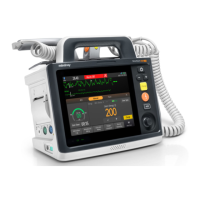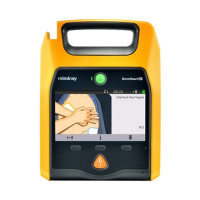7 - 1
7 CPR Assistance
7.1 CPR Assistance Safety Information
• Perform CPR on a patient on firm ground if possible. When you perform CPR on a patient lying on a
mattress, a backboard must be used to limit the amount of compressed depth which is absorbed by
the mattress. Depending on characteristics of the mattress, backboard and patient, the
compensation depth does not guarantee that the patient chest is compressed by 50 mm.
• When the patient is breathing with high frequency or in the treatment of high-frequency
ventilation, the CPR assistance disturbed by the thoracic movements may provide inaccurate
feedback. You should count compressions by yourself and not rely on the compression rate provided
by the CPR assistance in such conditions.
• The CPR assistance is not intended for use in a moving environment, such as an ambulance. If used
during patient transport, the CPR assistance may provide inaccurate feedback. If CPR is indicated in
a moving environment, do not rely on feedback provided by the CPR assistance in such conditions.
• The CPR sensor is not available in the markets of UK, Germany and France.
7.2 CPR Metronome
• The CPR metronome sounds do not indicate information regarding the patient’s condition. Because
patient status can change in a short time, the patient should be assessed at all times. Do not perform
CPR on a patient who is responsive or is breathing normally.
• The settings of CPR metronome are affected by the settings of Voice Prompts and Voice Volume in
the AED Setup menu.
7.2.1 Viewing Filtered ECG Waveform
• The CPR filter works only when you perform CPR using electrode pads or the CPR sensor.
• CPR compressions introduce CPR artifact into the ECG signal. The CPR filter relies on the correlation
between CPR compressions and CPR artifacts from the ECG signal. The filtered ECG waveform should
be used as a reference for the real waveform. Because the CPR filter will not remove all CPR artifact
in some conditions. For example, in the case of asystole or low amplitude pulseless electrical activity
(PEA), the residual artifact after filtered looks like fine ventricular fibrillation. You should always
follow the standard procedure of stopping CPR to verify the patient’s ECG rhythm before making
treatment decisions.
• There is a slight delay between the original and filtered ECG waveforms.

